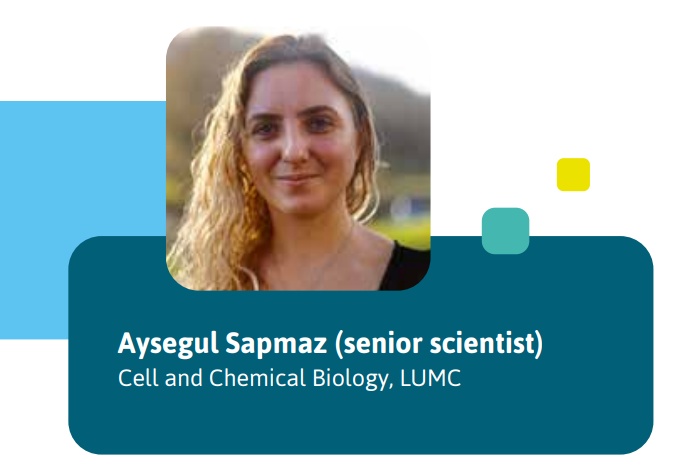Aysegul Sapmaz moved to Ovaa's group at the NKI after finishing her PhD as a molecular biologist at the Middle East Technical University in Ankara, Turkey. The move to NKI was no coincidence, Aysegul tells us, as she already joined the Ovaa group as a visiting PhD student at the latest stage of her PhD research. "As a biologist, I find it magical to combine chemistry and biology here. We bring out so many cool ideas together." One of these ideas was to study the reversible ubiquitylation of Rab-proteins in the context of endosomal trafficking and immunity. Based on published data from the collaboration of the Ovaa and Neefjes groups and some preliminary chemical experiments, Aysegul wrote a proposal for this ICI project with Huib Ovaa and Sjaak Neefjes, which was granted in 2019.
Searching for the missing link
Rab GTPases are key regulators of various steps in the endo-lysosomal system. They are critical in a number of stages of antigen presentation. Rab7 is such a GTPase. The Ovaa and Neefjes labs have recently described how reversible ubiquitylation of Rab7 controls the endo-lysosomal system. Although they found that reversible ubiquitylation of Rab7 is controlled by a deubiquitinase called USP32, so far, it had remained unclear what the specific ligase is. Therefore, the project aimed to identify the ligase responsible for Rab GTPase ubiquitylation. "We think that this E3 ligase will provide targets for small molecule-mediated modulation of the immune response," explains Aysegul.
Another aim was to find small molecules that can target the enzymes that are modulating the reversible ubiquitylation of Rab GTPases and can inhibit this process. Finding such an inhibitor would allow researchers to investigate the mechanism of the process and identify targets for immunotherapy.
Bridge between chemistry and biology
Initially, Aysegul and PhD student Esther ter Linden in the Sjaak Neefjes group started on the project. "After Huib's passing, I moved on to mentoring more PhD students, and most lab work was done by one of my PhD students" she recalls.
With the project in its final stages this summer, most targets have been met. "We have identified a potential E3 ligase," says Aysegul. "It is a good candidate for a drug target, but we are still validating it. After validating and characterizing our small molecule compound targeting USP32 in a simple system, we are also studying the turnover of the T-cell receptors and the release of cytolytic granules by activated cytotoxic T-cells, and we hope to see the effect of our compound."
But the best result was finding a small molecule that inhibits USP32, says Aysegul. "We have really impressive data from proteomics, cell-based experiments, and biochemistry. We have been able to combine our expertise in chemistry and biology to find this really potent inhibitor." The researchers have named the inhibitor Huib32 (Human deUbiquitinase Inhibitor 32).
Aysegul stresses the collaboration between the former Ovaa-lab and the Neefjes lab. "I feel like a bridge between chemistry and biology, as I work in both labs. The project shows how chemistry can help understand biology and vice versa." She has just received a grant from NWO to follow up this research, studying the role of de-ubiquitinating enzymes in lysosomal dysfunction in neurodegeneration illnesses such as dementia.
Project Finding and manipulating ubiquitylation of Rab GTPases in endosomal traffic and immunity
Aysegul Sapmaz (senior scientist)
Cell and Chemical Biology, LUMC
This article was published in ICI Bulletin 15, June 2023.
